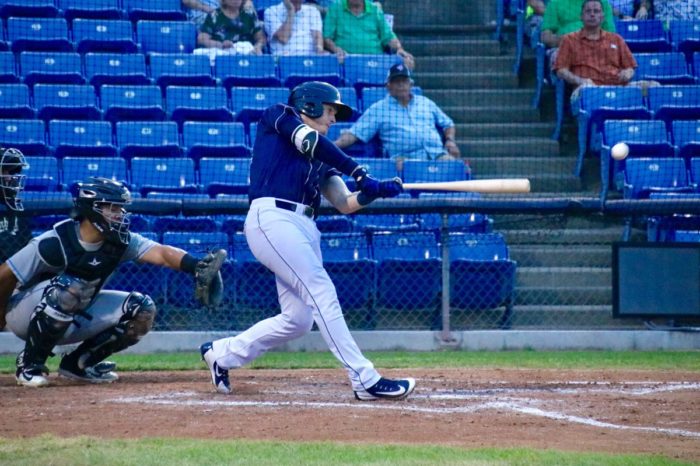
Will Toffey/Photo by Logan Barer, MMO
Will Toffey
Position: 3B B/T: L/R Age: 12/31/94 (24)
Acquired: Traded from the Oakland Athletics for Jeurys Familia (July 21, 2018)
Previous Rank: N/A
2018 Stats (Single-A, Binghamton): .248/.375/.406, 20 2B, 9 HR, 51 RBI, 2 SB
Just a couple of weeks before his acquisition. Toffey was also rated the Athletics 7th best prospect by Fangraphs in their midseason update. Now, Toffey finds himself atop the Mets suspect third base prospect rankings.
Carrying a skill set that scouts saw as projectable, Toffey was taken in the 23rd round of the 2014 by the New York Yankees out of high school, but opted to take up his commitment to Vanderbilt. Following a less than stellar Sophomore year, Toffey was drafted by the Baltimore Orioles in the 25th round, and once again, Toffey opted to not sign. This ended up being an excellent decision as he broke out in his Junior year (.424 point increase in his OPS), which led to him being taken in the 4th round of the 2017 draft by the Oakland Athletics.
Widely regarded as a solid defender at third base, his defensive value as always a primary feature that had teams interested in him, especially with his throwing arm, which is currently rated as a 70 on the prospect scale by Fangraphs. A fringe average runner, he’s relying on excellent instincts and already quick reactions to get to what he needs to field.
Defense aside, it’s his eye at the plate that gave scouts the optimism that his bat could come around. In his last two college seasons, Toffey walked more than he struck out holding K:BB ratios of 51:44 in 264 plate appearances in 2016 and 48:30 in 262 plate appearances in 2017. Toffey’s patience at the plate has translated to his professional career. According to Baseball America, Toffey had the best strike-zone discipline tool in the A’s organization. Overall,Toffey has a career 15.8 percent walk rate throughout his minor league career.
In addition to his plate discipline, it’s Toffey’s ability to make adjustments which has been an indicator of Toffey’s past and hopefully future success. He’s always had a wide stance at the plate, but early on in his college career, he didn’t anchor his back leg much and as a result didn’t generate much power. In his breakout Junior season, Toffey started to turn into his swing more, generating more torque, which lead to him tripling his Freshman and Sophomore combine home run total.
Now, Toffey has a fairly open stance with a toe tap that closes his stance. Toffey then brings his front leg forward in a quick path. When he’s off, his rhythm pulls away from turning into his swing, and it becomes mainly arms and shoulders. That causes him to then rolls his hands on inside pitches, producing weaker contact. When his swing is on, Toffey drives the ball and turns some of that cage power into in-game power, while being able to use all fields. Nevertheless, he’ll have to keep this up on a consistent basis to convince scouts that he’ll have enough bat to translate to third base at the major league level.
These adjustments led to a decent start to his 2018 campaign hitting .281/.465/.344 over 44 PA before dislocating his shoulder. Toffey would miss six weeks before returning on the last day of May. In is first six games back, Toffey hit .476/.577/.714 before his bat went silent for the rest of the month.
When Toffey joined the Mets organization and was promoted to Double-A Binghamton, he took off. His extra base hit prowess improved with the Metshitting a third more doubles than he he had all season with the A’s and hitting just one fewer home run less in just 32 fewer plate appearances. His ISO improving from .140 to .179 made him look a bit more like what scouts saw in him in that last season in Vanderbilt. What is most impressive about this is that he did all of this with a shoulder in need of surgery.
Ultimately, 2019 will be the true barometer for where Toffey’s place in the Mets organization is. One thing to look out for is whether the power continues post-shoulder surgery. Given high OBP, he will need to hit for power to have a clearer path to the show. Defensively, he needs to show no ill-effects from the surgery whether that comes in the form of a change in his arm slot or a reduction in his excellent arm strength or accuracy. Shoulder injuries can get tricky quickly, and it’s certainly something that will be monitored with a diligent eye.
Previous Rankings
50-46 Led by Michael Paez
45-41 Led by Ranfy Adon
40-36 Led by Anthony Dirocie
35-31 Led by Ryley Gilliam
30-26 Led by Chris Viall
25 Carlos Cortes
24 Ali Sanchez
23 Eric Hanhold
22 Luis Carpio
21 Freddy Valdez
20 Walker Lockett
19 Junior Santos
18 Gavin Cecchini
17 Jordan Humphreys
16 Christian James
15 Tony Dibrell
14 Francisco Alvarez

